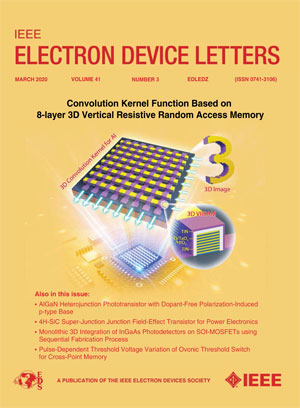掺钇Hf 0 .₅Zr 0。₅O₂基铁电电容器,在4 K时表现出无疲劳(>10₁₂循环),长保留和抗压性能
IF 4.1
2区 工程技术
Q2 ENGINEERING, ELECTRICAL & ELECTRONIC
引用次数: 0
摘要
这项工作首次展示了在低温低至4 K的情况下,钇掺杂${\mathrm {Hf}}_{\mathbf {{0}.{5}}}$${\mathrm {Zr}}_{\mathbf {{0}.{5}}}$${\mathrm {O}}_{\mathbf {{2}}}$基铁电电容器(Y-HZO帽)的电学特性,突出了其优越的耐久性和可靠性。由于低温下氧空位(o -空位)分布减少,畴钉钉减少(由于捕获减少),Y-HZO帽在4k时的快速脉冲表征显示2Pr $\sim ~20~\mu $${\mathrm {C/cm}}^{\mathbf {{2}}}$,显示>33% improvement compared to results at 300 K. Notably, the Y-HZO caps show fatigue-free endurance up to $10^{\mathbf {{12}}}$ cycles at 4 K, while undoped ${\mathrm {Hf}}_{\mathbf {{0}.{5}}}$ ${\mathrm {Zr}}_{\mathbf {{0}.{5}}}$ ${\mathrm {O}}_{\mathbf {{2}}}$ ferroelectric capacitors (HZO caps) exhibit slight fatigue. Both capacitors (caps) show imprint immunity an long retention ( $\gt 10^{\mathbf {{5}}}$ s). A key observation is that while HZO caps do not require wake-up at 4 K, Y-HZO caps show an anti-ferroelectric behavior, implying wake-up operation cannot be performed in Y-HZO caps at 4 K. The Y-HZO caps must be woken up at 300 K before further electrical analysis at 4 K. These findings point towards the reduced mobility of charged defects and O-vacancies significantly suppressing the domain de-pinning process at 4 K, which plays an essential part in the wake-up and fatigue of these ferroelectric capacitors. The time-dependent dielectric break- down (TDDB) analysis also points towards improved reliability of both the caps at 4 K. These improved characteristics and reliability of Y-HZO caps make them an attractive choice for cryogenic memory applications like quantum and neuromorphic computing.本文章由计算机程序翻译,如有差异,请以英文原文为准。
Yttrium Doped Hf₀.₅Zr₀.₅O₂ Based Ferroelectric Capacitor Exhibiting Fatigue Free (>10₁₂ Cycles), Long Retention, and Imprint Immune Performance at 4 K
This work demonstrates the first electrical characterization of yttrium-doped ${\mathrm {Hf}}_{\mathbf {{0}.{5}}}$ ${\mathrm {Zr}}_{\mathbf {{0}.{5}}}$ ${\mathrm {O}}_{\mathbf {{2}}}$ -based ferroelectric capacitors (Y-HZO caps) at cryogenic temperatures down to 4 K, highlighting their superior endurance and reliability. Owing to a decrease in oxygen vacancy (O-vacancy) distribution and less domain pinning (due to reduced trapping) at cryogenic temperatures, the fast pulse characterization reveals 2Pr $\sim ~20~\mu $ ${\mathrm {C/cm}}^{\mathbf {{2}}}$ of Y-HZO caps at 4 K, showing >33% improvement compared to results at 300 K. Notably, the Y-HZO caps show fatigue-free endurance up to $10^{\mathbf {{12}}}$ cycles at 4 K, while undoped ${\mathrm {Hf}}_{\mathbf {{0}.{5}}}$ ${\mathrm {Zr}}_{\mathbf {{0}.{5}}}$ ${\mathrm {O}}_{\mathbf {{2}}}$ ferroelectric capacitors (HZO caps) exhibit slight fatigue. Both capacitors (caps) show imprint immunity an long retention ( $\gt 10^{\mathbf {{5}}}$ s). A key observation is that while HZO caps do not require wake-up at 4 K, Y-HZO caps show an anti-ferroelectric behavior, implying wake-up operation cannot be performed in Y-HZO caps at 4 K. The Y-HZO caps must be woken up at 300 K before further electrical analysis at 4 K. These findings point towards the reduced mobility of charged defects and O-vacancies significantly suppressing the domain de-pinning process at 4 K, which plays an essential part in the wake-up and fatigue of these ferroelectric capacitors. The time-dependent dielectric break- down (TDDB) analysis also points towards improved reliability of both the caps at 4 K. These improved characteristics and reliability of Y-HZO caps make them an attractive choice for cryogenic memory applications like quantum and neuromorphic computing.
求助全文
通过发布文献求助,成功后即可免费获取论文全文。
去求助
来源期刊

IEEE Electron Device Letters
工程技术-工程:电子与电气
CiteScore
8.20
自引率
10.20%
发文量
551
审稿时长
1.4 months
期刊介绍:
IEEE Electron Device Letters publishes original and significant contributions relating to the theory, modeling, design, performance and reliability of electron and ion integrated circuit devices and interconnects, involving insulators, metals, organic materials, micro-plasmas, semiconductors, quantum-effect structures, vacuum devices, and emerging materials with applications in bioelectronics, biomedical electronics, computation, communications, displays, microelectromechanics, imaging, micro-actuators, nanoelectronics, optoelectronics, photovoltaics, power ICs and micro-sensors.
 求助内容:
求助内容: 应助结果提醒方式:
应助结果提醒方式:


